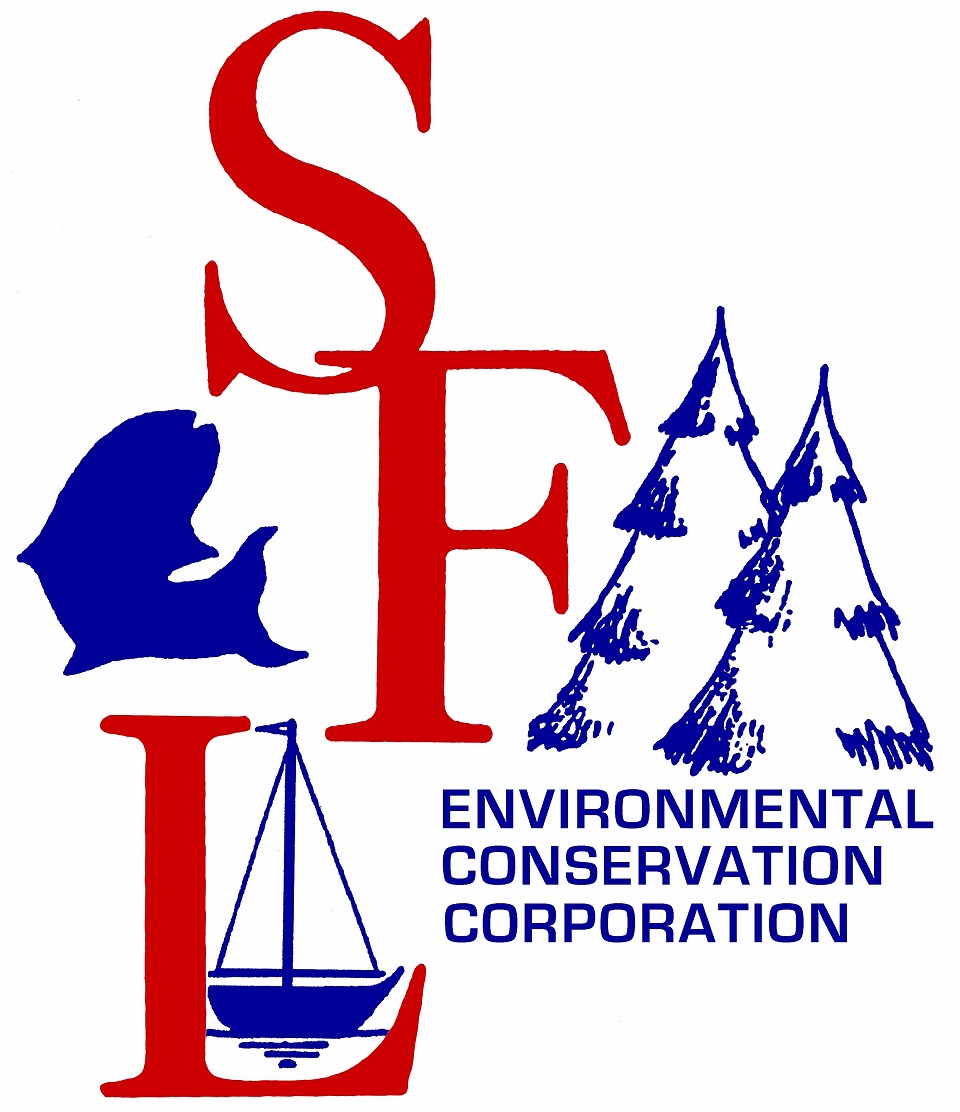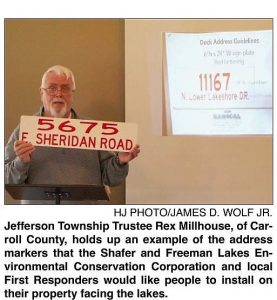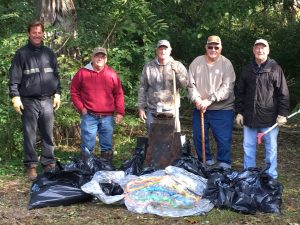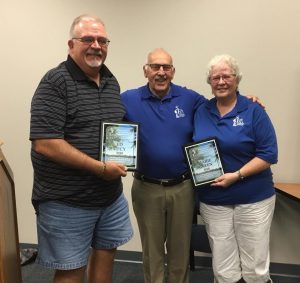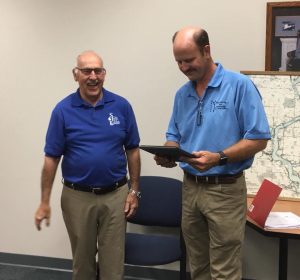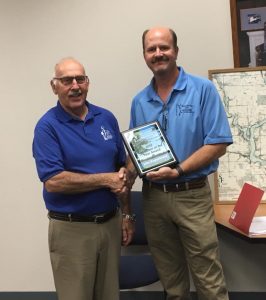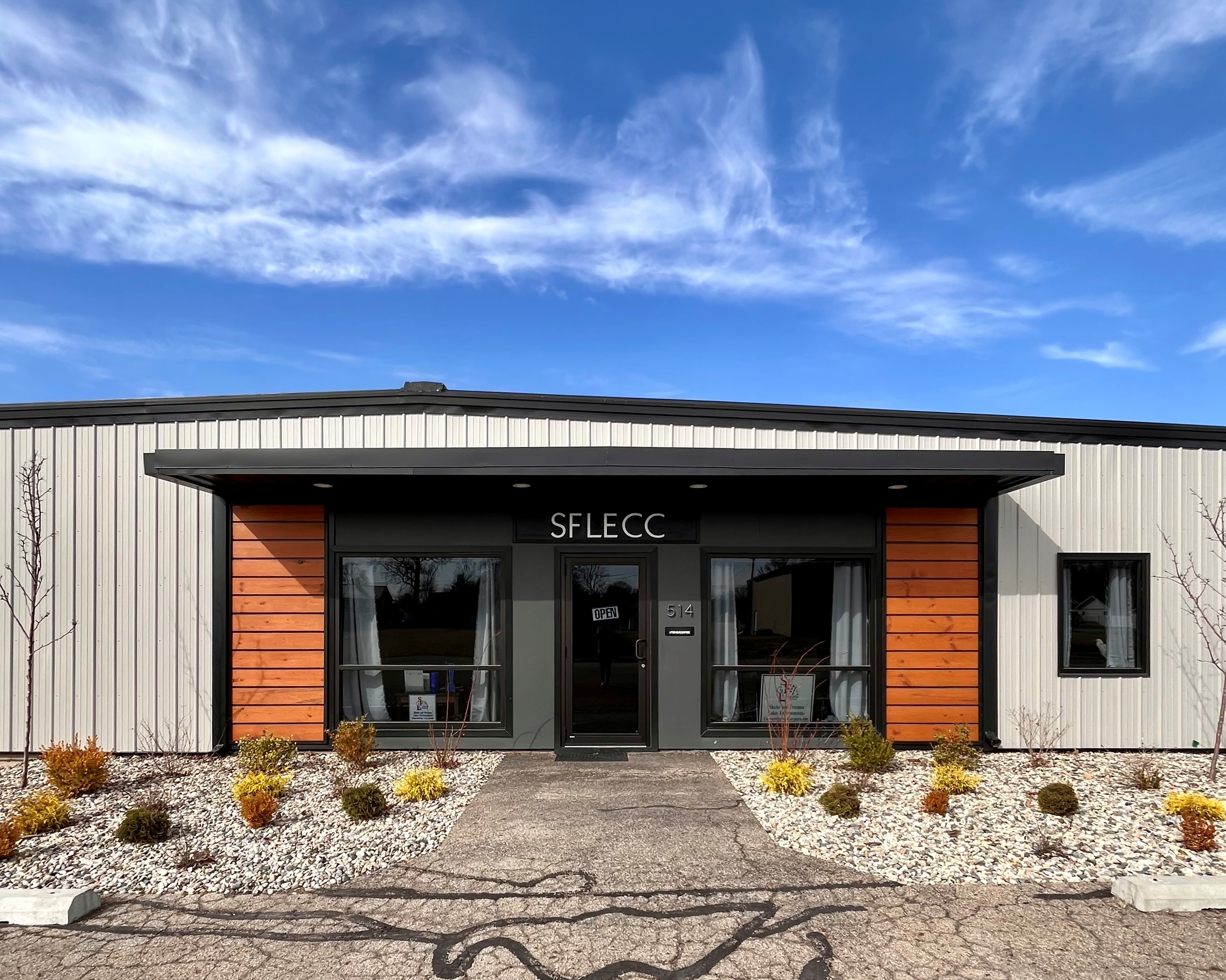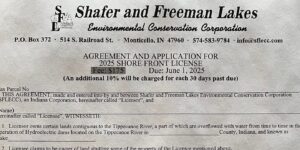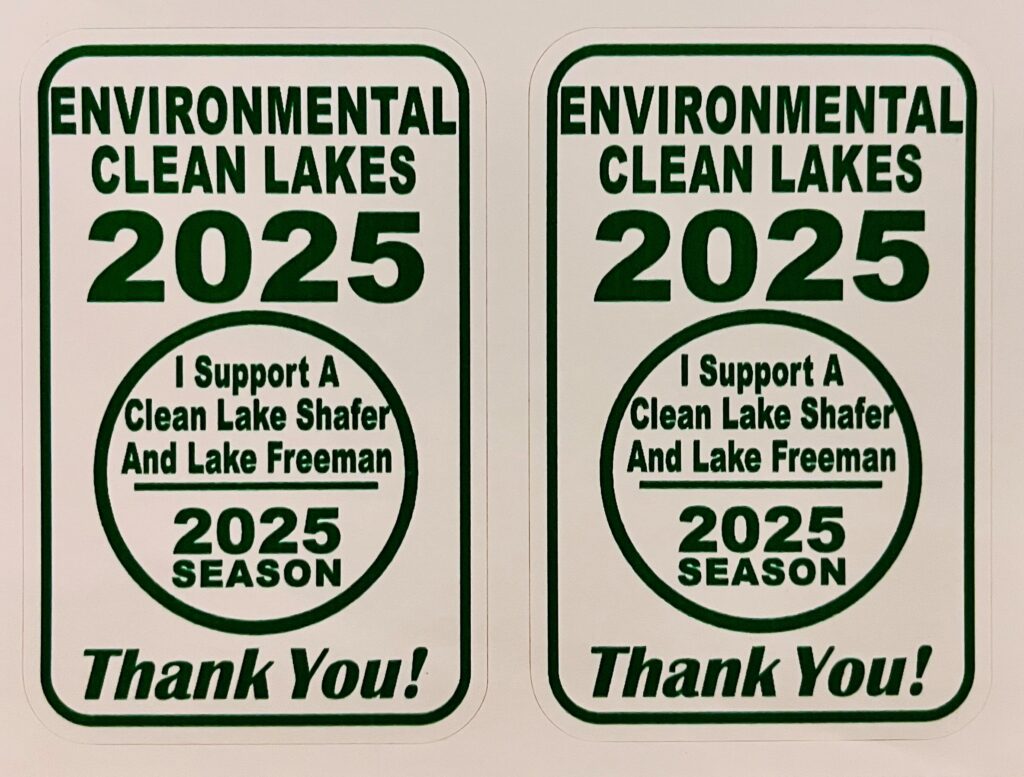The Twin Lakes are going to get a little safer for those who need an ambulance or rescue services while on the water. A group of about 30 people met at the Monticello Fire Dept and decided on an address plate that will go on docks or somewhere on property facing the water. The roughly 6″x24″ sign is white with red letters, the address number being 3″ high and the street name below it being 2″ high and can be purchased for around $20 at Radical Graphics in Monticello (574)870-8873. Purchasing and putting up a sign is voluntary but would definitely help in a variety of ways on Lakes Freeman & Shafer.
Author: sfleccadmin (Page 9 of 12)
“We are elated that the Federal Energy Regulatory Commission has decided to grant a rehearing on their June 21st order,” said SFLECC president Lee Kreul. “While we were deeply disappointed that FERC’s final decision was not in our favor, we rolled up our sleeves and went to work.” The SFLECC met with the staffs of U.S. Representative Todd Rokita, U.S. Senator Todd Young and U.S Senator Joe Donnelly and asked them to contact FERC on its behalf. “We are extremely thankful that our elected officials put pressure on FERC. Without the help of Rep. Rokita, Senators Young and Donnelly, we believe FERC would have let the deadline pass and ignored our request.” In his letter to the FERC commissioners, U.S. Representative Rokita called FERC’s final order “heavy-handed” and repeated the SFLECC’s concerns that FWS’ order “gravely harms the City of Monticello, the Lake Freeman community and imperils small businesses, property values, tourism, tax revenue and health and safety.”
FERC’s June 21st order permanently amended Northern Indiana Public Services Company’s (NIPSCO) license to open the gates at the Oakdale Dam during “abnormal low flow” events in order to siphon water from Lake Freeman onto the habitat of endangered mussel species found below Oakdale Dam. Despite FERC’s own staff “alternative recommendation” to the license that included NIPSCO’s cessation of power generation during low-flow events and for NIPSCO to “act to maintain” the lake level on Lake Freeman, in the final ruling, the commissioners stated that they were “constrained” by the Endangered Species Act. The final order gave a 30-day deadline for a request to rehear the decision. The SFLECC filed the request on July 21st, citing:
- U.S. Fish and Wildlife Service’s (FWS) own “biological opinion” declared that “the FERC Staff Alternative, as proposed, is “not likely to jeopardize the endangered species”, therefore, FERC should make the decision their own staff recommended.
- FERC erred by accepting the FWS’s self-proclaimed “best science”, despite contrary evidence presented by FERC and SFLECC’s expert hydrologists.
- The lowering of Lake Freeman caused harm to the environment, species and property values of lake residents.
The issue began during a drought in the summer of 2012, that resulted with the U.S. Fish and Wildlife Service issuing a Technical Assistance Letter (TAL) in 2014 that mandated NIPSCO, the owner of Oakdale-Norway Project, to open the gates and send 500 CFS water from Lake Freeman during “low flow events”. The FWS, citing the Endangered Species Act, mandated NIPSCO to temporarily violate its FERC issued operating license that required NIPSCO to keep the lake levels close to its “run-of-the-river” designation; guidelines that had been in effect for over 80 years.
Kreul admitted that the SFLECC is unclear what the rehearing will entail, but he added “we are still in this battle and using every means possible to fight for our lakes!”
The Shafer and Freeman Lakes Environmental Conservation Corporation (SFLECC) recently filed a request for a rehearing with the Federal Energy Regulatory Commission (FERC) on an order by the FERC Commissioners to make the temporary License FERC issued to NIPSCO in 2014 for the Norway-Oakdale hydroelectric project on the Tippecanoe River permanent. The FERC Order ostensibly supports the request of the US Fish and Wildlife Service (FWS) for more water to be let out through the Oakdale Dam in times of abnormal low river flow into Lakes Freeman and Shafer. The purpose of the directive is to support endangered species of mussels.
Strangely, the decision by the Commissioners is counter to recommendations by FERC’s own staff for changes in the temporary license – changes that would have provided for more water for the lower river in times of abnormal low flows from upstream by reducing power generation at the Oakdale Dam, thus avoiding extreme lowered lake levels.
Under the Temporary License, Lake Freeman was lowered 23 inches in 2014 causing closure of the Lake to boaters. Just this past week, during a declared abnormal low flow period, under the temporary License NIPSCO dropped the Lake 3 inches. After several periods of rain It has since returned to traditional levels. Access and boating on the Lake is curtailed when the water level drops 12 inches or more from its target level of normal 612.45 ft.
SFLECC President Lee Kreul and SFLECC’s Lake Levels Task Force Chair John Koppelmann stated that, “Obviously we are very disappointed in the FERC Commissioners ruling to make the 2014 Temporary License permanent. We want them to reconsider their actions. Over the last five years, despite countless man hours, money spent and the financial support from the governments of White and Carroll counties, the city of Monticello and the Twin Lakes and the public, we have come up short of our goal to seek agreement from the FERC Commissioners that the natural flow of the river and holding the Lake levels constant, was the best alternative for all parties. We have no doubt that, with their Order the Lakes will continue to suffer minor and major drops in levels for lengthy periods, and closures of Lake Freeman, especially during the summer months, will occur. We also must consider that the waters of Lake Shafer could also eventually be tapped.”
Among the points in their Request for Rehearing SFLECC lists several major errors by the FERC Commissioners in their ruling:
- The Commissioner’s ruling ignores the fact that FWS in its’ Biological Opinion admitted that the FERC’s Staff Alternative for operation of the Oakdale dam was “not likely” to jeopardize the continued existence of the endangered mussels or adversely affect their habitat. Yet FWS insisted that their approach to controlling flow is superior and demands it be used.
- The commissioners erred by automatically accepting FWS self-proclaimed hydrological methodology as embodying the “best science” available and ignored testimony by other noted hydrological scientists with contrary views. Also, contrary to Federal law it (FWS), did not detail the qualifications of FWS personnel who developed the FWS methodology.
- By Federal law the Commission is not obligated to automatically accept FWS’ self-proclaimed “best science”. To do so is contrary to the Commission’s responsibility.
- The Commission erred by not considering the riparian rights of property owners around the Lakes, denying the property owners access to the Lakes fronting their properties.
- The Order violates the Due Process Clause of the U.S. Constitution due to the inequitable treatment of owners of property along lake Freeman in comparison to property owners on Lake Shafer.
Clink on the following link to view the request: Request for Rehearing
CONTACT INFORMATION FOR SFLECC
Lee Kreul, President – lkreul@comcast.net (765)412-2984
John Koppelmann, Lake Levels Task Force Chair – John@Johnsellshomes.com (574)583-3171
An Abnormal Low Flow (ALF) Event Watch has been issued for Lake Freeman, as the prior 24 daily average for flows at the Winamac USGS gauge dropped to 300 cubic feet per second (cfs) or below, or 600 cfs or below at the Oakdale USGS gauge.
As of July 17, the 24 hour daily average at the Winamac USGS gauge is 298 cfs and the 24 hour daily average at the Oakdale USGS gauge is 573 cfs.
The surface elevation taken near the face of the Oakdale Hydroelectric Dam was measured at 610.33 below the normal operating target of 610.35ft. The change in surface elevation measured at the hydro does not reflect or equate to the same potential change in depth for other areas of the lake. Surface elevation is the relative measurement to sea level, local datum. A change of .01 ft in the surface elevation equates to 1/100th of a foot or .12 inches. NIPSCO does not measure average depths. Lake levels have not been impacted at this time, but this could be a possibility so please be aware.
Indiana Department of Natural Resources Conservation Officers, remind the public to be mindful of their surroundings and be aware of any submerged objects in or underneath the surface of the water. Due to the water levels objects such as tree stumps, old dock pilings and such may start to show or become a hazard to boat operators, swimmers, and tubers.
The annual meeting of the Shafer Freeman Lakes Environmental Conservation Corporation will be on Saturday, August 25, 2018 in the IU-Health White Memorial Hospital – Hibner Room. The meeting will begin at 10:00 a.m.
Five board positions will be filled at the meeting. Any person interested in being on the SFLECC board is asked to send their resume to:
SFLECC
Attn: Nominating Committee
P.O. Box 372
Monticello, IN 47960
Resumes must be received no later than July 18, 2018. Only members of the SFLECC are entitled to vote. Directors must be legal residents of the State of Indiana.
Members of the corporation consist of persons who have a paid current Shore Front License or have made a donation twice the amount of a standard Shore Front License during the calendar year. They could also be a recorded member of an association with a paid current Shore Front License. Members are encouraged to attend this meeting. Ballots will be available at the registration desk. Please ask about responsibility pertaining to a Directorship.
The SFLECC is in search of an older pontoon no more than 22 ft to transform into a work barge and a boat motor at least 50 hp in good working condition. If anyone knows of anything like this available and would be willing to donate, please contact our office at 574-583-9784. It’s a win-win, we get a boat and motor to help keep the lakes clean and you get a tax deduction!
“We should certainly count our blessings, but we should also make our blessings count.”
-Neal A. Maxwell
 ~From the SFLECC Board & Staff
~From the SFLECC Board & Staff
SHAFER & FREEMAN LAKES ENVIRONMENTAL CONSERVATION CORPORATION
(SFLECC)
FOR IMMEDIATE RELEASE
MONTICELLO, INDIANA
DATE: October 11, 2017
CONTACT: Lee Kreul, President lkreul@comcast.net, 765 412-2984
On October 3rd the Washington, D.C. law firm of Smith, Currie and Hancock, attorneys for the Shafer and Freeman Lakes Environmental Conservation Corporation (SFLECC), filed a twenty-page letter with the Secretary of the Federal Energy Regulatory Commission (FERC) on behalf of SFLECC and its Coalition Partners. Who are classified as “interested parties” in the controversy between the US Fish and Wildlife Service (FWS) and FERC over Lake Freeman and Shafer water level controls. The letter contests the findings of the FWS Biological Opinion (BO) published on July 5, 2017. Copies of the SFLECC letter and the FWS Biological Opinion are available on the SFLECC web site at: www.SFLECC.org.
According to Lee Kreul, SFLECC President, “We have had discussion with FERC and FWS about dam control, lake levels and mussel mortality stretching as far back as 2012. Hopefully, the issue is coming to a conclusion very soon.” In the last three years SFLECC, its coalition partners, expert witnesses, and private citizens have strongly protested the operating rules for abnormal low flow water periods. The low water rules were originally requested by FWS in a Technical Assistance Letter (TAL) to FERC in 2014. This led FERC to order NIPSCO, under a new temporary license, to follow the FWS request.
“We (SFLECC) have filed countless documents with FERC containing expert scientific evidence and arguments urging FERC to understand the fallacy of the hydrological science behind the FWS TAL and to have the low water rules overturned”, said Kreul. Through their attorneys and in public meetings, SFLECC has continually cited the damages that have already occurred and they say that damages will continue if the use of the FWS TAL as the basis for dam control is not overturned.
In the letter SFLECC points to the testimony of expert witnesses who have determined that the FWS insistence on the use of linear scaling as the basis for dam control in low water conditions is not “the best science available” and ignores presented evidence to the contrary. Very significantly the SFLECC letter also attacks the legal foundation of FWS intervention into dam control stemming from FWS own statements in their Final BO that the FERC Staff Alternative for operational changes in dam operations “are not likely to jeopardize the continued existence of the clubshell, fanshell, sheepnose or rabbits foot mussels and is not likely to destroy or adversely modify designated critical habitat ”.
The latest FWS statement now appears to be a reversal of their earlier position and brings into question the legality of FWS to dictate dam operational measures to FERC. SFLECC attorneys argue that since the FWS final Biological Opinion states that harm to endangered mussels and their habitat is “not likely” to occur if the FERC Staff Alternative are put in place; then FWS has no legal authority under the Endangered Species Act and under the FWS “not likely” statement to seek to impose their own formula for dam operations. Further, that it is FERC, not FWS, who legally have the right to determine whether to proceed and in what manner, not FWS.
FERC published its own Opinion in August of this year. FERC’s findings essentially agree with and resemble the SFLECC findings and recommendations for changes in dam operations during abnormal low flow periods (ALF). Meanwhile FWS is holding to the position it established in 2014 that the TAL offers the best methodology for avoiding harm to endangered mussels.
Procedurally FWS and FERC are nearing the end of the list of federally recommended actions for resolving regulatory disagreements between Federal agencies. The decision now clearly rests with FERC. The FERC commissioners will have to decide whether to (1) make permanent the temporary NIPSCO license as is; or (2) cancel the temporary license and Introduce new regulations as promulgated by FERC staff. If the FERC Commissioners vote to adopt the FERC Staff Alternative, then future lake levels will remain at normal levels during dry periods and will not be lowered as they were in August 2014 and August 2016 to satisfy FWS demands.
The temporary license has allowed NIPSCO to comply with the TAL without fear of violating the Endangered Species Act. The new procedures recommended by the FERC staff call for NIPSCO to shut down power production during ALF events and operate the dams as to provide constant lake levels, even during ALF periods. FERC maintains the position that the new procedures would establish natural river flow during ALF periods and are “not likely” to result in harm to the mussels and thus not violate the Endangered Species Act.
OTHER CONTACT INFORMATION FOR SFLECC
John Koppelmann, Lake Levels Task Force Chair john@johnsellshomes.com 574 583-3171
Gabrielle Haygood, Executive Director info@sflecc.com 574 583-9784
ABOUT SFLECC – The Shafer & Freeman Lakes Environmental Conservation Corporation was formed in 1994 to take title to Lake Freeman and Shafer shorelines and other nearby properties owned by NIPSCO. It is a non-profit corporation whose Articles of Incorporation state its mission is “to promote environmentally sound use of Lake Shafer and Lake Freeman. The corporation will conduct itself in a way to protect and enhance the environment and the water quality of these lakes in order to facilitate public recreational use. The Corporation will accomplish this purpose through various activities, including but not limited to, the issuance and administration of permits for the use of shoreline property, the testing of the water quality, monitoring shoreline quality and ensuring continued public access.” The SFLECC Board of Directors meets at 7:00PM on the third Thursday of each month at the IU White Memorial Hospital. Meetings are open to the public.
